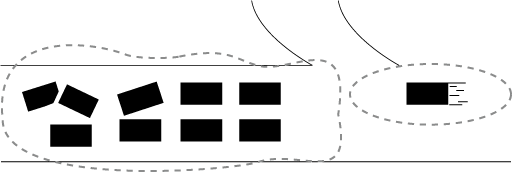December 15, 2003
Ad-hoc car networks
One of my favorite new tech ideas is the low-power ad-hoc network. It's simple, powerful and leverages the fact that people in a given geographic location are likely to have similar interests. I like it because it's a fundamentally human-level concept, rather than being about making the technology somehow more efficient (though it does that, too, by reducing the amount of communication that's likely unrelated to what people are interested in and thus reducing the needs for filtering/routing information).
While stuck in traffic in Turin, I had the idea of making ad-hoc automotive networks that could reduce traffic congestion. When you're pulling up a long line of cars, you generally have no idea how long the line is or how quickly it's moving. From the foreshortened perspective on the tail of the line, it's virtually impossible to judge whether you should pull off at the next off-ramp, wait it out or offroad across the median and go the other way. However, a tight pack of cars is the perfect situation for an ad-hoc network:

As a car approaches a pack of other cars, it connects to their network. The pack of cars can tell the new car the average speed and size of the network (and if there's GPS information, maybe even the beginning and end of the pack), which the driver--maybe with the help of some mapping software--can use to determine whether to stay in the pack or get off at the next available opportunity:

Moreover, once the network is established, there can be all kinds of things that the network can do. There can be games, shared music collections, chat, dating, whatever. Moreover, this removes the need for a large all-seeing/all-knowing centralized traffic control system, which I think has been one of the problems of the intelligent highway world, and not all cars need to participate in it--just enough for a network to be established (though this one fact--the sparse network effect--could be the one thing that slows/prevents adoption of this system). The WiFi caravan shows that it can be done technically.
...oh, and this idea doesn't even take into account information that could be passed to the network, and to individual cars, by oncoming traffic--they know all kinds of things about the road we're about to travel on that we don't, what can they tell us?
Posted by mikek at December 15, 2003 12:28 AM | TrackBackOne thing I forgot to mention is that this wouldn't be a network exacly like a Bluetooth or 802.11b network, where all of the devices can see all of the other devices. A taffic jam is long and a car's broadcast radius is, by my definition, small. So there would, essentially, a local network with the cars in the immediate vicinity and a way to route messages so that if A sees B and B sees C, A and C can still pass messages to each other (like the default "Hello, this taffic jam is 10 miles long." message)--and there could potentially be many B's between A and C. Now, I'm not a network person, but I think that this problem has been solved. It's certainly how P2P networks seem to work and, on a larger scale, how packet routing seems to work in general.
Posted by: Mike at December 15, 2003 07:40 AMYou might want to look here: http://www.amasci.com/amateur/traffic/ .
Also the "links" page seems worth a visit. ;)
Posted by: fabio at December 17, 2003 05:34 AMOn a related note: Magicbikes!
(http://www.nytimes.com/2003/12/15/technology/15wifi.html)
The obvious improvement here is to use the pedals to generate power for the battery-- that way if they ever run low, you'd just have to ride around a bit to charge 'em.
And what if the cars and bikes could be on the same network...?
Thanks for the links! This thing is the bomb: http://www.mtreiber.de/MicroApplet
Posted by: Mike at December 17, 2003 04:08 PM